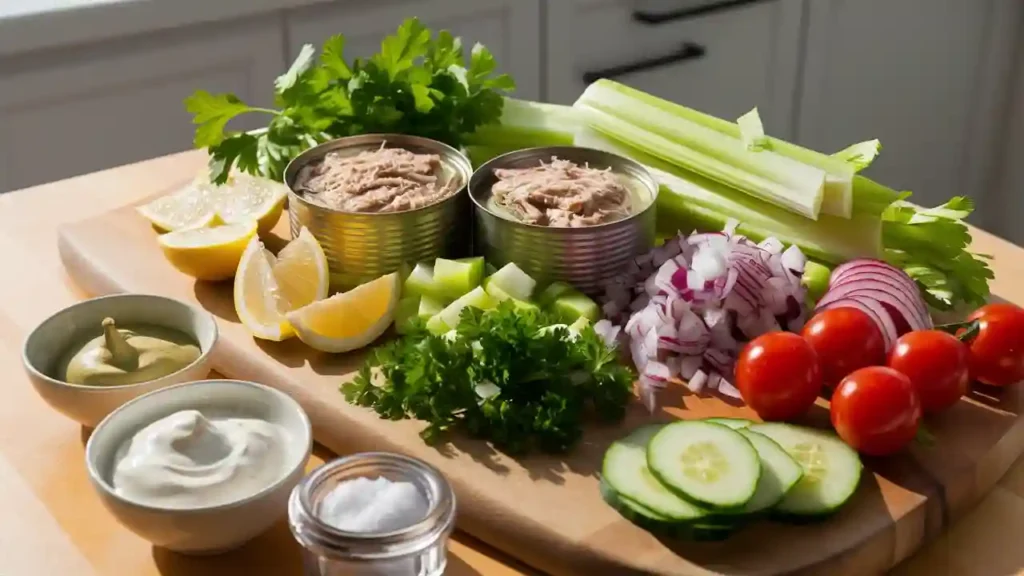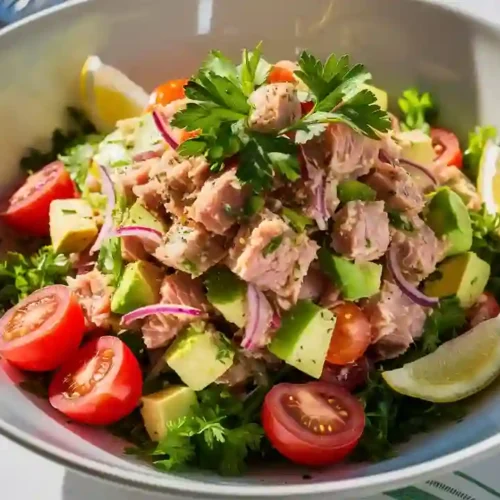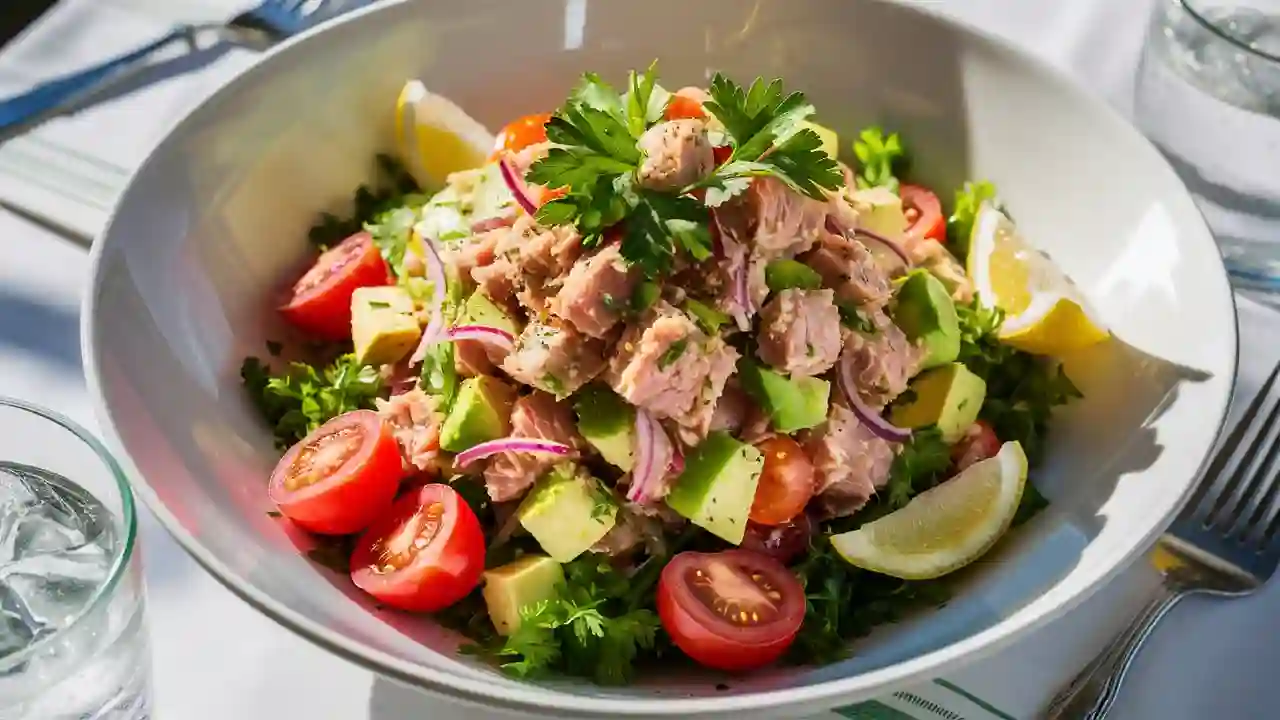Last Updated on March 16, 2025 by Lucas
Looking for a quick, high-protein meal that’s light, flavorful, and ready in 10 minutes? This healthy tuna salad combines lean protein, fresh veggies, and zesty flavors — perfect for a satisfying lunch or snack. Whether you serve it in a sandwich, wrap, or salad bowl, it’s a versatile, no-cook recipe you’ll keep coming back to.
Why This Healthy Tuna Salad Is a Must-Try
Your healthy tuna salad is a game changer. It delivers lean protein and omega-3s. You gain muscle support. Omega-3s help your heart and brain [1]. The recipe is quick and needs no cooking. It fits your busy life and weight loss plan.
Key Benefits
- Lean Protein:
- Tuna fuels your body.
- It supports muscle growth.
- It keeps you full longer.
- Omega-3 Fatty Acids:
- They protect your heart.
- They boost brain health.
- They reduce inflammation (Harvard Health Publishing).
- Quick & No Cooking Required:
- It takes under 10 minutes.
- Ideal for busy days.
- Easy and hassle-free.
- Low-Calorie & Weight Loss-Friendly:
- Use Greek yogurt instead of mayo.
- Enjoy a light yet satisfying meal.
- Control calories without sacrificing taste.
Give this healthy tuna salad a try. Adjust it to your taste. Share your version with friends. Your feedback is welcome. Enjoy every bite, and keep cooking healthy meals.
Ingredients You’ll Need for a High-Protein Tuna Salad
Crafting a high-protein tuna salad is a delightful journey that combines taste with nutrition. By selecting quality ingredients, you can create a dish that’s both satisfying and beneficial to your health.

Choosing the Right Tuna: Albacore vs. Light
Your choice of tuna sets the foundation for your salad:
- Albacore Tuna: Known for its firm texture and mild flavor, albacore tuna is rich in omega-3 fatty acids, which support heart health and reduce inflammation. However, it contains higher fat and calorie content compared to light tuna.[2]
- Light Tuna: Typically sourced from smaller tuna species like skipjack, light tuna has a stronger flavor and softer texture. It’s lower in fat and calories, making it a suitable option for those monitoring their intake.[3]
Incorporating Healthy Swaps
Enhance your salad’s nutritional profile with these substitutions:
- Greek Yogurt: Replacing mayonnaise with Greek yogurt adds creaminess while boosting protein content. Greek yogurt also introduces probiotics, supporting digestive health.[4]
- Avocado: Mashed avocado contributes healthy monounsaturated fats, promoting heart health, and adds a rich, buttery texture.[5]
Adding Crunch and Freshness
Incorporate vegetables to elevate texture and flavor:
- Celery: Offers a satisfying crunch and is rich in antioxidants, aiding in reducing inflammation.[6]
- Cucumber: Provides refreshing juiciness and contains compounds that support hydration and skin health.[7]
- Onion: Adds a zesty kick and contains quercetin, an antioxidant with anti-inflammatory properties.[8]
Enhancing Flavor with Boosters
Elevate your salad’s taste with these additions:
- Lemon Juice: Brightens flavors and offers vitamin C, supporting the immune system.[9]
- Dijon Mustard: Introduces a tangy depth without excess calories, enhancing the overall flavor profile.
- Olive Oil: A drizzle of extra-virgin olive oil adds richness and provides antioxidants and healthy fats, supporting heart health.[10]
By thoughtfully selecting and combining these ingredients, you can craft a high-protein tuna salad that’s both delicious and nourishing. Enjoy the process of tailoring the salad to your taste preferences, making it a satisfying addition to your culinary repertoire.
How to Make This Healthy Tuna Salad in 10 Minutes
Creating a healthy tuna salad is both quick and satisfying. By selecting nutritious ingredients, you can craft a dish that’s both delicious and nourishing. Here’s how:

1. Choose the Right Tuna
Opt for tuna packed in water to reduce calorie intake. Albacore tuna offers a milder flavor and firmer texture, while light tuna, often from species like skipjack, has a stronger taste. Both are excellent choices; select based on your personal preference.[11]
2. Incorporate Healthy Binders
Traditional tuna salads often rely on mayonnaise, but you can lighten the dish by using:
- Greek Yogurt: Provides creaminess and a protein boost.
- Avocado: Offers healthy fats and a rich texture.
- Hummus: Adds a unique flavor and additional nutrients.[12]
Feel free to experiment with these options or combine them to suit your taste.
3. Add Crunch with Fresh Vegetables
Incorporate finely chopped:
- Celery: For a crisp texture.
- Cucumber: Adds refreshing juiciness.
- Red Onion: Provides a mild, sweet bite.
These vegetables enhance the salad’s crunch and nutritional profile.
4. Enhance Flavor with Zesty Additions
Elevate your salad’s taste by mixing in:
- Dijon Mustard: Introduces tanginess.
- Lemon Juice: Offers brightness.
- Fresh Herbs (like parsley or dill): Impart freshness.
These elements work harmoniously to create a balanced and flavorful salad.
5. Assemble and Serve
Combine all your chosen ingredients in a bowl, mixing gently to combine. You can serve your healthy tuna salad in various ways:
- On Whole Grain Bread: For a hearty sandwich.
- In Lettuce Leaves: Creating refreshing wraps.
- Over Mixed Greens: As a light salad.
This versatility allows you to enjoy the salad in a manner that suits your dietary preferences.
6. Storage Tips
If you have leftovers, store the salad in an airtight container in the refrigerator. It will maintain its quality for up to 3-4 days, making it ideal for meal prepping.[13]
Serving Ideas: Ways to Enjoy Your Healthy Tuna Salad
Your healthy tuna salad is versatile and can be enjoyed in various ways. Here are some delicious options to consider:

1. Stuff It into Whole Grain Bread for a Protein-Packed Sandwich
Whole grain bread adds fiber and nutrients, making it a wholesome choice for your tuna salad sandwich.
2. Wrap It in Lettuce for a Low-Carb Option
For a refreshing, low-carb alternative, use large lettuce leaves to wrap your tuna salad. This method adds crunch and keeps the meal light.[14]
3. Scoop It Over Greens for a Light, Healthy Salad Bowl
Serving your tuna salad over a bed of mixed greens or spinach creates a satisfying salad that’s both nutritious and filling.
Additional Serving Suggestions
To further customize your tuna salad experience, consider these ideas:
- In a Pita Pocket: Fill whole-grain pita pockets with your tuna salad for a convenient and tasty meal.
- On Whole Wheat Crackers: Enjoy your tuna salad as a spread over whole wheat crackers for a crunchy snack or appetizer.
- With Sliced Vegetables: Pair your tuna salad with sliced cucumbers, bell peppers, or celery sticks for added freshness and texture.
Tips for Enhancing Your Tuna Salad
- Add Fresh Herbs: Incorporate chopped parsley, dill, or cilantro to brighten the flavor.
- Incorporate Crunchy Elements: Mix in diced celery, red onion, or bell peppers for added crunch.
- Experiment with Dressings: For a twist, try using Greek yogurt, mashed avocado, or a squeeze of lemon juice instead of traditional mayonnaise.
Feel free to mix and match these serving ideas to keep your meals exciting and tailored to your preferences.
Conclusion
Incorporating this healthy tuna salad into your diet offers a delightful fusion of taste and nutrition. By combining lean protein, heart-healthy omega-3 fatty acids, and a variety of fresh vegetables, you create a meal that’s both satisfying and beneficial for your well-being. Whether you enjoy it as a sandwich, wrap, or salad, this versatile dish caters to diverse preferences and dietary needs. Embracing such wholesome recipes can enhance your culinary repertoire while supporting a balanced lifestyle.
______________________

Healthy Tuna Salad
Ingredients
- 1 can 5 oz tuna in water, drained
- 1/4 cup plain Greek yogurt
- 1 tablespoon Dijon mustard
- 1/4 cup celery finely chopped
- 1/4 cup red onion finely chopped
- Salt and pepper to taste
- Optional: Fresh parsley chopped, for garnish
Instructions
- In a medium bowl, combine the drained tuna, Greek yogurt, and Dijon mustard.
- Add the chopped celery and red onion to the bowl.
- Season with salt and pepper to taste.
- Mix all ingredients until well combined.
- Refrigerate for at least 30 minutes to allow flavors to meld (optional but recommended).
- Serve on whole-grain bread, in lettuce wraps, or over a bed of greens.
- Garnish with chopped fresh parsley if desired.
Notes
- Calories: 150
- Protein: 20g
- Carbohydrates: 5g
- Fiber: 1g
- Fat: 7g
- Sodium: 300mg
FAQs
Is salad with tuna healthy?
Yes, incorporating tuna into your salad can be a healthy choice. Tuna is rich in protein and omega-3 fatty acids, which are beneficial for heart and brain health. However, the overall healthiness of the salad depends on the ingredients and dressings you choose. Opting for fresh vegetables and healthier dressings can enhance its nutritional value.[15]
What is a healthy substitute for mayonnaise in tuna?
If you’re looking to reduce fat and calorie content, consider these healthier alternatives to mayonnaise in your tuna salad:
Greek Yogurt: Offers a creamy texture with added protein.
Avocado: Provides healthy fats and a rich, smooth consistency.
Hummus: Adds a flavorful and creamy element.
Mustard: Gives a tangy kick with fewer calories.
Tahini: Offers a nutty flavor and creamy texture.
These substitutes can help you tailor your tuna salad to your dietary preferences while maintaining taste.
Can I eat tuna salad while losing weight?
Tuna salad can be part of a weight loss plan if prepared thoughtfully. Using light or fat-free dressings, incorporating plenty of vegetables, and moderating high-calorie ingredients can make your tuna salad a satisfying and nutritious option that aligns with your weight loss goals.[16]
What is the healthiest way to eat tuna?
To maximize health benefits, consider the following tips when consuming tuna:
Choose Fresh or Canned Tuna Packed in Water: This reduces calorie and fat intake.
Limit High-Sodium Options: Opt for low-sodium versions when possible.
Balance with Vegetables: Combine tuna with a variety of vegetables for added nutrients and fiber.
Be Cautious with Mercury Levels: Limit consumption of high-mercury tuna species, especially for pregnant individuals.[17]
Is tuna OK to eat every day?
While tuna is a nutritious food, consuming it daily may lead to excessive mercury intake, particularly with certain species like albacore. It’s advisable to vary your protein sources and limit tuna consumption to a few times a week.[18]
What can I mix with canned tuna?
Canned tuna is versatile and pairs well with various ingredients:
Vegetables: Chopped celery, onions, bell peppers, and cucumbers add crunch and freshness.
Fruits: Diced apples or grapes can introduce a sweet contrast.
Legumes: Chickpeas or beans boost fiber and protein content.
Whole Grains: Quinoa, brown rice, or whole-grain pasta make the meal more filling.
Nuts and Seeds: Almonds, walnuts, or sunflower seeds provide healthy fats and texture.
Cheese: Cubed mozzarella or feta adds richness.
These additions can enhance the flavor, texture, and nutritional profile of your canned tuna dishes.

